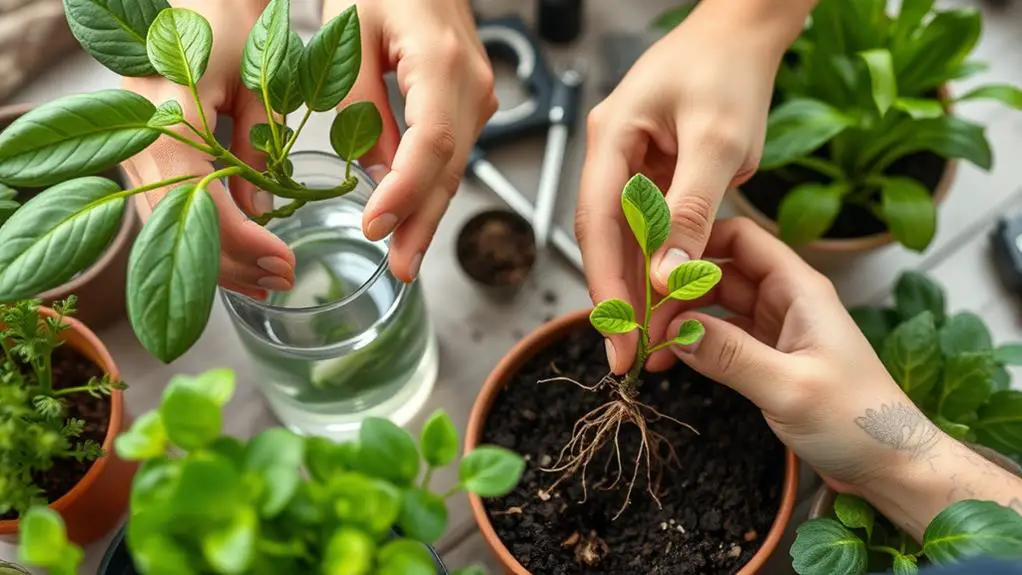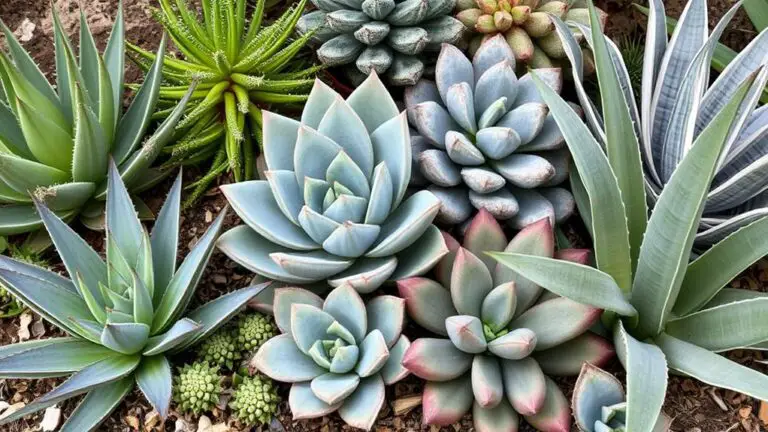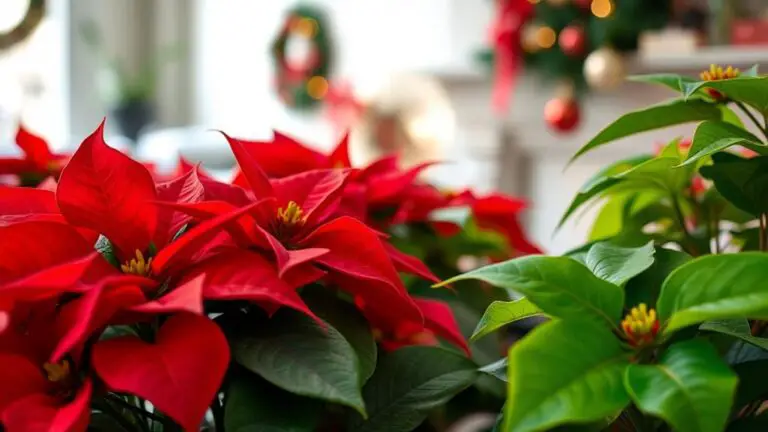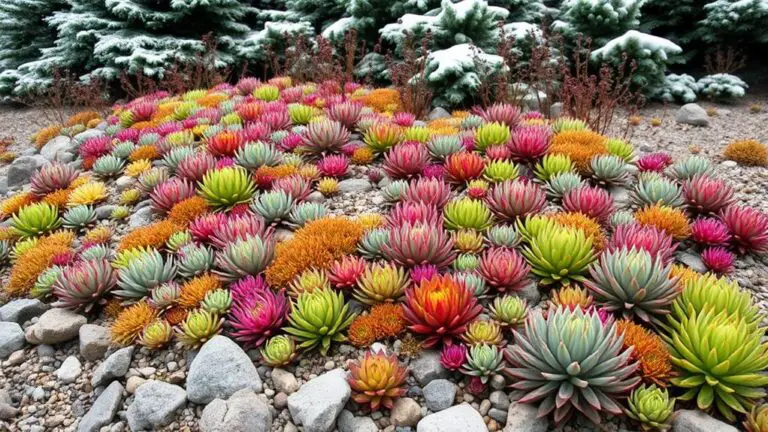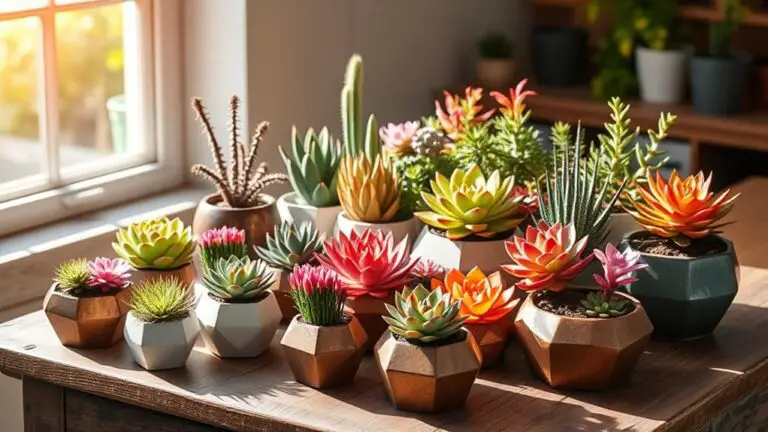5 Steps to Successfully Propagate Your Houseplants: The Complete Guide
If you're looking to expand your indoor garden without breaking the bank, mastering the art of plant propagation is a must. By following five straightforward steps, you can successfully create new plants from your existing ones. You'll start by selecting the appropriate propagation method tailored to your plant's species. From there, you'll need to gather and prepare your tools and workspace. But what comes next can make or break your propagation success. Want to guarantee your new plants thrive and grow? Let's explore the essential techniques that follow.
Choose the Right Propagation Method
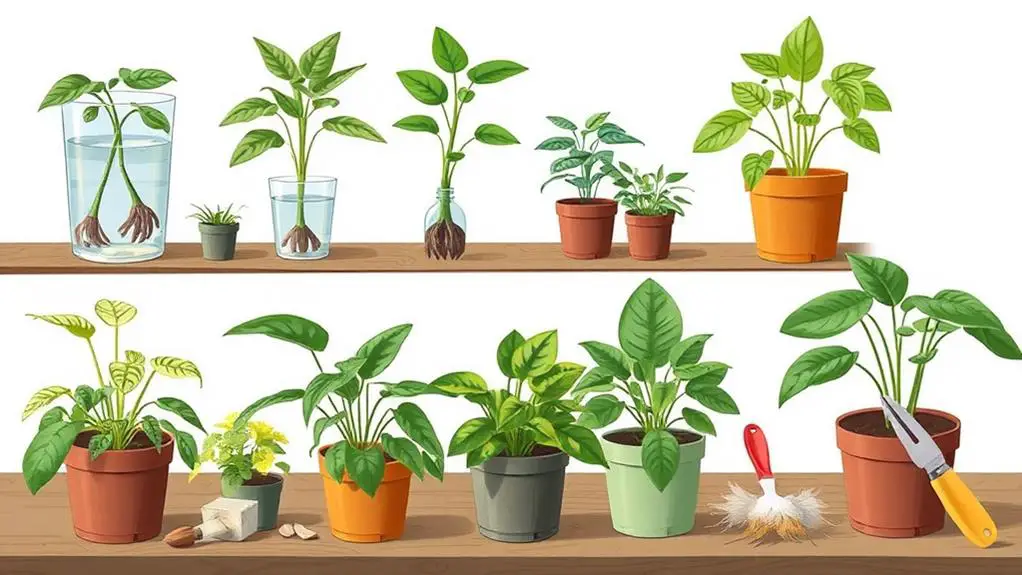
When choosing the right propagation method, start by considering the type of houseplant you have. Different plants need different approaches for successful propagation.
For instance, if you have a pothos, stem cuttings are your best bet. Simply make a clean cut below a node and place the cutting in water to watch the roots develop. Once rooted, transfer it to a well-draining potting mix.
Leaf cuttings work wonders for snake plants and jade plants. Make certain to use clean cuts and let the leaves dry for a day or two before planting them in soil. This waiting period helps prevent rot and guarantees better rooting.
For clump-forming plants like peace lilies and ZZ plants, dividing is ideal. Do this in spring for the best results. Ensure each divided section has an intact root ball for replanting.
The water method is a great way to see roots grow quickly. Just remember to eventually transfer the plant to soil for long-term health.
Prepare Your Tools and Work Area
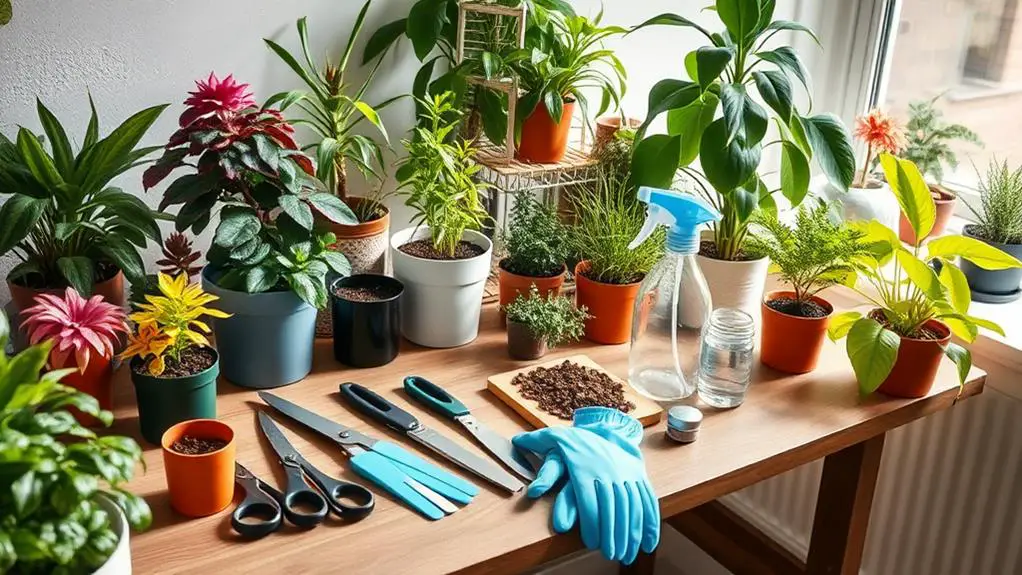
Preparing your tools and work area is vital for successful houseplant propagation. It's important to have everything ready to go before you start.
First, gather all the necessary tools: sharp, clean scissors or pruning shears, plant pots, and a suitable propagation medium like perlite or vermiculite. These items will help guarantee your houseplants grow strong and healthy.
Next, make certain your workspace is clean and organized. Sterilize your tools with rubbing alcohol to prevent any risk of disease transmission. An organized workspace reduces stress and helps you focus on the task at hand.
Choose a well-lit area for propagation. Bright, indirect sunlight is essential for encouraging healthy root development.
Here's a simple checklist to follow:
- Confirm Tools are Sharp and Clean: Sterilize with alcohol to avoid contamination.
- Organize Your Workspace: Keep everything tidy to make the process smoother.
- Prepare Propagation Medium: Moisten but don't saturate it, as proper moisture management is key.
Take Cuttings or Divisions
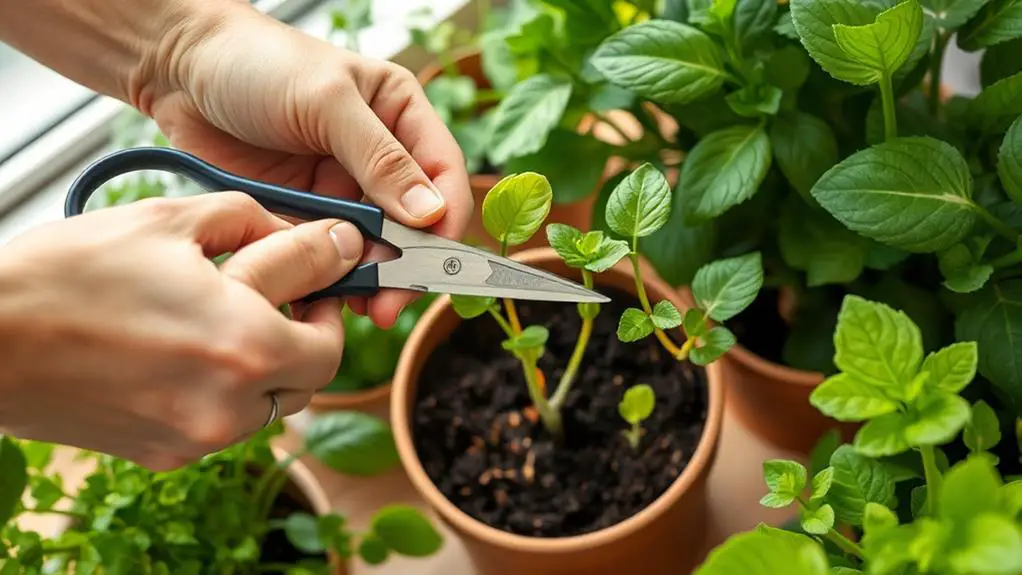
Taking cuttings or divisions embodies the art of propagation, allowing you to expand your houseplant collection with minimal effort.
To take cuttings, select healthy stems or leaves that are 3-6 inches long with at least two nodes. For stem cuttings, make a clean cut just below a leaf node. If you're using leaf cuttings, include a small portion of the stem, known as the petiole, to enhance rooting chances. After cutting, dip the ends in rooting hormone to promote faster root development, then plant them in well-draining soil or water.
When dividing houseplants, the best time is in spring. Carefully remove the plant from its pot, and gently separate the root ball into sections. Verify each division has intact roots. This method is perfect for plants that have outgrown their pots.
Remember to monitor moisture levels in the propagation medium. Keep it consistently moist but not saturated to prevent rot and encourage healthy growth.
Root and Monitor Growth

Rooting and monitoring growth are essential steps in ensuring your houseplant cuttings take hold and thrive. To successfully propagate houseplants, you must focus on creating the right conditions for root development. Here's how you can do it:
1. Maintain Moisture: Keep the rooting medium consistently moist but not saturated. Proper moisture levels are vital to prevent rot and promote successful root development.
If you're using water, change it every 1-2 weeks to avoid stagnation and disease.
2. Provide Indirect Light: Place your cuttings in a spot with bright, indirect light. This helps them perform photosynthesis without risking sunburn.
Direct sunlight can be too harsh and might damage the delicate cuttings.
3. Ensure Warmth: Keep the cuttings in a warm environment, ideally between 75°F and 80°F. This temperature range is perfect for encouraging root growth.
You can use a heating mat if your home is cooler.
Regularly monitor growth by checking for new shoots or a slight resistance when gently tugged, indicating root formation.
Following these steps will help you create the ideal conditions for rooting, ensuring your cuttings grow into healthy plants. Keep an eye on them, and you'll be rewarded with thriving houseplants!
Transplant and Care for New Plants
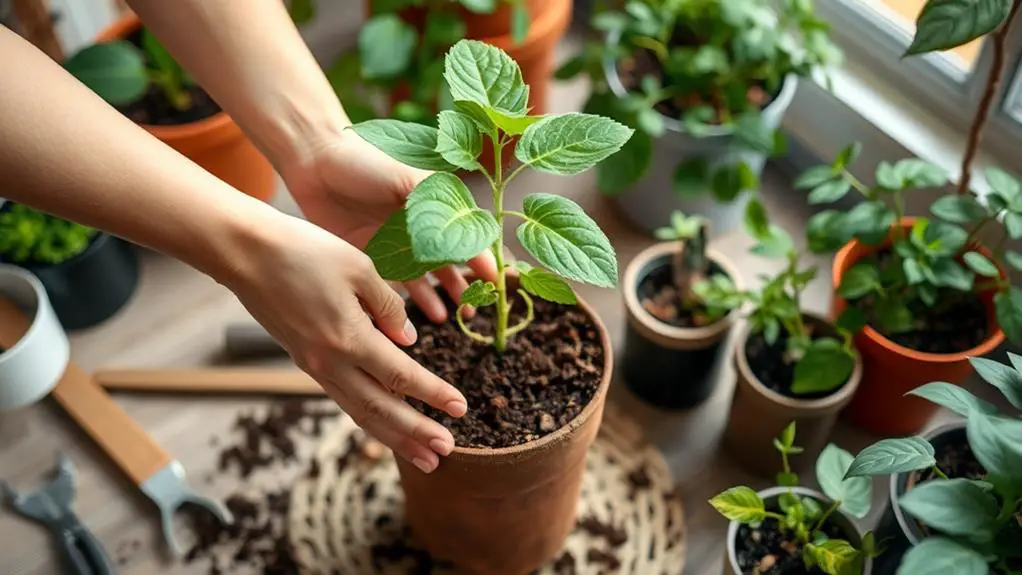
Once your houseplant cuttings have successfully rooted, it's time to transplant them into well-draining soil to foster healthy growth.
Start by choosing a pot that's one size larger than the current container. This gives the roots room to grow without overwhelming the plant. Carefully remove the new plant from its propagation medium, ensuring you don't damage the roots. Place it gently in the new pot and fill in with soil around the root ball.
Next, water thoroughly to help settle the soil and eliminate air pockets. But be careful not to overwater, as this can lead to root rot.
After watering, place the transplanted plant in a spot where it will receive indirect light. This helps it acclimate without being stressed by too much direct sunlight.
Maintaining consistent humidity is key for the plant's adjustment. You can use a humidity tray or mist the leaves regularly. This helps the plant adjust and encourages robust growth.
Keep an eye on your new plant and give it time to acclimate. With the right care, your transplanted houseplants will thrive, showing healthy root development and vibrant new growth.
You've got this!
Frequently Asked Questions
How to Propagate Plants Step by Step?
To propagate plants, start with the right method for your plant type. Use clean tools, create ideal conditions, and monitor for issues. Once roots develop, transplant carefully. Keep providing indirect light and moisture as it acclimates.
How Do You Propagate an Indoor House Plant?
Start by picking a healthy plant and choose the right method: stem cuttings, leaf cuttings, or division. For stem cuttings, use rooting hormone, keep soil moist, and provide bright, indirect light to guarantee successful propagation.
What Are the Stages of Propagation of Plants?
You start with selecting a healthy parent plant and taking cuttings. Then, prepare the propagation medium and plant the cuttings. Maintain ideal conditions, monitor growth, and finally acclimate the new plants to their permanent location.
What Is the Most Common Propagation Method for Indoor Plants?
The most common propagation method for indoor plants is stem cuttings. You cut a healthy stem just below a leaf node, then place it in water or soil. Consistent moisture and indirect light help roots develop.
Conclusion
You've got this! By following these five steps, you're well on your way to becoming a houseplant propagation pro. Just remember to choose the right method, keep your tools and area clean, take healthy cuttings, monitor their growth, and transplant them with care. With a bit of patience and attention, your new plants will thrive. So, roll up your sleeves, trust the process, and enjoy watching your green family grow. Happy gardening!

